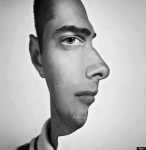AHI and what it means
-
HoseCrusher
- Posts: 2744
- Joined: Tue Oct 12, 2010 6:42 pm
Re: AHI and what it means
What I find interesting is that when you measure an oximeter everyone immediately focuses on oxygen saturation levels...
Yes it does monitor those, but it also measures the hearts response throughout the monitoring period.
I guess it comes down to perspective. My cardiologist focuses on the heart rate changes in my oximetry reports, then check to see if the change was caused by a drop in O2, or something else. I am under the impression that frequent arousal's also show up as hear beat irregularities, at least they did in my case. My cardiologist wasn't worried about the few seconds my oxygen levels dropped below 90%, but immediately focused on the heart beat irregularities that he saw in my report.
After starting xPAP therapy, those irregularities were greatly reduced.
I wouldn't be quick to throw out overnight oximetry tests. A trained person can find a lot of useful information in them even if the oxygen saturation level doesn't drop too far.
Yes it does monitor those, but it also measures the hearts response throughout the monitoring period.
I guess it comes down to perspective. My cardiologist focuses on the heart rate changes in my oximetry reports, then check to see if the change was caused by a drop in O2, or something else. I am under the impression that frequent arousal's also show up as hear beat irregularities, at least they did in my case. My cardiologist wasn't worried about the few seconds my oxygen levels dropped below 90%, but immediately focused on the heart beat irregularities that he saw in my report.
After starting xPAP therapy, those irregularities were greatly reduced.
I wouldn't be quick to throw out overnight oximetry tests. A trained person can find a lot of useful information in them even if the oxygen saturation level doesn't drop too far.
_________________
| Mask: Brevida™ Nasal Pillow CPAP Mask with Headgear |
| Additional Comments: Machine is an AirSense 10 AutoSet For Her with Heated Humidifier. |
SpO2 96+% and holding...
-
keroseneburner
- Posts: 132
- Joined: Wed Aug 05, 2015 9:52 am
Re: AHI and what it means
No apologies needed. I am quite honored my thread went 3 pages and even veered towards a lock for a bit. I am new to this forum but I suspect it is like many others.....a family, maybe a little bit dysfunctional but a family nonetheless. I have been trying to im nanwilson but keep getting an error message. I contacted the board admin to see what is up.
Thanks again for all the help and info
Burner
Thanks again for all the help and info
Burner
s9 Autoset
humidifier
heated tube
amaraview mask
humidifier
heated tube
amaraview mask
Re: AHI and what it means
, I pm'd you, just go to your messages and hit the reply button and you can answer me back. Pugsy has the info on the Encore software, you can get it from her.
Cheers
Nan
Cheers
Nan
_________________
| Machine: ResMed AirSense™ 10 AutoSet™ CPAP Machine with HumidAir™ Heated Humidifier |
| Mask: AirFit™ P10 Nasal Pillow CPAP Mask with Headgear |
Started cpap in 2010.. still at it with great results.
-
keroseneburner
- Posts: 132
- Joined: Wed Aug 05, 2015 9:52 am
Re: AHI and what it means
Ok, I set the limits from 7-10. The 90% went to 9.0 but the AHI went to 4.5 from an average of 2.5. Maybe I should up the limits.
s9 Autoset
humidifier
heated tube
amaraview mask
humidifier
heated tube
amaraview mask
Re: AHI and what it means
It's the minimum pressure that is the most critical pressure setting.
When set too low the machine has to continually try to "fix" things with more pressure and it doesn't change the pressure quickly at all. It goes up in stages and while it is going up trying to hold the airway open the airway can still collapse and you get a higher AHI.
It's better to have a more optimal minimum pressure doing a better job holding the airway open in the first place so that the airway doesn't have a chance to try to collapse as often.
It works better trying to prevent the collapse than it does trying to fix things after the fact.
If you up the maximum pressure it still takes as long to get from 7 to where it might need to go and since the 90% pressure is only at 9 the machine isn't getting to the max of 10 very much as it is now...allowing it a higher range won't really change that 90% pressure even if you set it to 20 cm max. If the minimum is still 7 cm the 90% pressure will still likely be 9 cm. Just because the machine can go higher doesn't mean that it will go higher.
The minimum pressure is the most critical pressure setting when using apap mode. Needs to be high enough to do a good job of holding the airway open in the first place and close enough to what pressure might be needed for the times during the night that more pressure might be needed (usually either supine sleeping or REM stage sleep).
When set too low the machine has to continually try to "fix" things with more pressure and it doesn't change the pressure quickly at all. It goes up in stages and while it is going up trying to hold the airway open the airway can still collapse and you get a higher AHI.
It's better to have a more optimal minimum pressure doing a better job holding the airway open in the first place so that the airway doesn't have a chance to try to collapse as often.
It works better trying to prevent the collapse than it does trying to fix things after the fact.
If you up the maximum pressure it still takes as long to get from 7 to where it might need to go and since the 90% pressure is only at 9 the machine isn't getting to the max of 10 very much as it is now...allowing it a higher range won't really change that 90% pressure even if you set it to 20 cm max. If the minimum is still 7 cm the 90% pressure will still likely be 9 cm. Just because the machine can go higher doesn't mean that it will go higher.
The minimum pressure is the most critical pressure setting when using apap mode. Needs to be high enough to do a good job of holding the airway open in the first place and close enough to what pressure might be needed for the times during the night that more pressure might be needed (usually either supine sleeping or REM stage sleep).
_________________
| Machine: AirCurve™ 10 VAuto BiLevel Machine with HumidAir™ Heated Humidifier |
| Additional Comments: Mask Bleep Eclipse https://bleepsleep.com/the-eclipse/ |
I may have to RISE but I refuse to SHINE.
-
keroseneburner
- Posts: 132
- Joined: Wed Aug 05, 2015 9:52 am
Re: AHI and what it means
Really good info. I am learing a lot here. My old cpap pressure was 11. I guess I should try 10 as a floor and see what happens. If my AHI drops I am on to something.
Burner
Burner
s9 Autoset
humidifier
heated tube
amaraview mask
humidifier
heated tube
amaraview mask
Re: AHI and what it means
I am glad you are getting called out on this. I have seen you post it many times, but I did not have the time to reply.tiredandscared wrote:Desats or rather (hypoxemia) as measured by SPO2 are the single most important factor in OSA. AHI is just a measurement of how well your throat muscles are working, it's more significant in measuring total arousals and sleep fragmentation. Only the length of an obstruction or the time inbetween are clinically significant.
You are making some generalizations that are wrong and worse yet, could mislead someone in managing their therapy.
I've seen horribly ill patients who had no or minor desats. Eventually we got them diagnosed and treated for UARS which is a form of OSA.Desats or rather (hypoxemia) as measured by SPO2 are the single most important factor in OSA.
No, AHI measures the number of breathing events per hour. It doesn't measure anything about the "throat muscles" (nor the airway muscles, nor the nerves connected to those muscles, nor the signals from the brain).AHI is just a measurement of how well your throat muscles are working
This could mislead someone who has a high number of arousals caused by breathing events with only short duration obstructions.Only the length of an obstruction or the time inbetween are clinically significant.
I don't find the way you approach this subject to be instructive or helpful to those who are learning the basics.
- Wulfman...
- Posts: 6688
- Joined: Mon Sep 01, 2014 6:41 pm
- Location: Nearest fishing spot
Re: AHI and what it means
Have you tried THAT pressure with this machine? (I'm presuming you're using a different/new machine)keroseneburner wrote:Really good info. I am learing a lot here. My old cpap pressure was 11. I guess I should try 10 as a floor and see what happens. If my AHI drops I am on to something.
Burner
If you haven't......why not?
Den
.
(5) REMstar Autos w/C-Flex & (6) REMstar Pro 2 CPAPs w/C-Flex - Pressure Setting = 14 cm.
"Passover" Humidification - ResMed Ultra Mirage FF - Encore Pro w/Card Reader & MyEncore software - Chiroflow pillow
User since 05/14/05
"Passover" Humidification - ResMed Ultra Mirage FF - Encore Pro w/Card Reader & MyEncore software - Chiroflow pillow
User since 05/14/05
-
keroseneburner
- Posts: 132
- Joined: Wed Aug 05, 2015 9:52 am
Re: AHI and what it means
My old machine was straight cpap. New machine is an auto. I figured if the pressure range included the 11 it would be good. I am learning more and more
s9 Autoset
humidifier
heated tube
amaraview mask
humidifier
heated tube
amaraview mask
- zoocrewphoto
- Posts: 3732
- Joined: Mon Apr 30, 2012 10:34 pm
- Location: Seatac, WA
Re: AHI and what it means
So, are you saying that I am NOT severe? My oxygen barely went below 90. I did have 79+ events per hour, never reached deep sleep, let alone REM. Sounds really healthy, doesn't it?tiredandscared wrote: Stop being a drama queen, go read some actual studies and books on OSA. "SOMEONE DISAGREES WITH ME, LIFE IS SO FRUSTRATING, I'M GOING TO DISENGAGE BECAUSE I CAN'T STAND SOMEONE HAVING DIFFERING OPINION THAN ME, RIGHT OR WRONG ". Facts are facts. Every single medical practioneer would agree with me that Sleep fragmentation/Sleep arousal<SPO2 desaturatons. You want base your understanding based simply on anecdotes and experiental stuff. Go head. But for the love of god, stop being so overly emotional about it. This goes for every single person on here.
With cpap, I have had huge improvements. Certainly felt like my sleep apnea is severe. Please don't dismiss people with fewer desats as not having a problem. Some people's brains fight back at the hint of an event, so they have more events and don't desat very much. Others don't react much, so have fewer events, but longer events that allow more desats. BOTH are serious. BOTH require treatment. Don't dismiss one type. That discourages people from getting treatment.
_________________
| Mask: Quattro™ FX Full Face CPAP Mask with Headgear |
| Humidifier: S9™ Series H5i™ Heated Humidifier with Climate Control |
| Additional Comments: Resmed S9 autoset pressure range 11-17 |
Who would have thought it would be this challenging to sleep and breathe at the same time?
-
tedburnsIII
- Posts: 354
- Joined: Sat Feb 28, 2015 4:49 pm
- Location: San Diego
Re: AHI and what it means
It is elementary that desats and AHI are not mutually exclusive, and further elementary that no titration is sufficient if desats go below 90%. Period.
Then the tech wants to also get RDI <5 for a so-called 'optimal' titration. Even a 'good' or 'adequate' titration with indeed higher RDI's require that minimum
Sp02 not go below 90%. And the opposite is true- obtain an RDI of 0, that is not the end of story- if minimum Sp02 goes below 90% they titrate to higher pressures.
So, one might argue that desats 90% or greater are threshhold requirements and underlying more important because one can more than get by with an RDI of 0 for titration purposes yet must still have that 90% minimum Sp02 baseline. So, it appears the pros are willing to sacrifice a higher RDI in order to obtain higher minimum desats.
I do note that one source that I found on the web (sleep specialist) has stated via means of an apparent powerpoint presentation that desats from 89% to 85% are considered mild, but one really wants at or above 90% when it comes to desats, which is considered 'normal'.
See: http://www.daveburrows.com/cpap/sleepst ... pstudy.pdf
Then the tech wants to also get RDI <5 for a so-called 'optimal' titration. Even a 'good' or 'adequate' titration with indeed higher RDI's require that minimum
Sp02 not go below 90%. And the opposite is true- obtain an RDI of 0, that is not the end of story- if minimum Sp02 goes below 90% they titrate to higher pressures.
So, one might argue that desats 90% or greater are threshhold requirements and underlying more important because one can more than get by with an RDI of 0 for titration purposes yet must still have that 90% minimum Sp02 baseline. So, it appears the pros are willing to sacrifice a higher RDI in order to obtain higher minimum desats.
I do note that one source that I found on the web (sleep specialist) has stated via means of an apparent powerpoint presentation that desats from 89% to 85% are considered mild, but one really wants at or above 90% when it comes to desats, which is considered 'normal'.
See: http://www.daveburrows.com/cpap/sleepst ... pstudy.pdf
Machine - https://www.cpap.com/productpage/resmart ... ducts.html
Setting: APAP, 10.5-14cm
Software: Proprietary
Mask- PR Wisp nasal (large); ResMed FX Nasal (wide);
Oximeter: CMS50D+
Setting: APAP, 10.5-14cm
Software: Proprietary
Mask- PR Wisp nasal (large); ResMed FX Nasal (wide);
Oximeter: CMS50D+
What Do You Die From?
SHHS wrote:Analyses were undertaken to assess whether the arousal frequency, the central apnea index, and measures of sleep-related hypoxemia (i.e., TST90) were associated with mortality. Regardless of age and other covariates, arousal frequency and the central apnea index (Tables 4 and 5) were not associated with mortality in men or women irrespective of whether these measures were modeled continuously or categorically. However, TST90 was a significant predictor of mortality in men less than 70 y in age, even after adjusting for age, race, smoking status, BMI, systolic and diastolic blood pressure, AHI, prevalent hypertension, diabetes, and cardiovascular disease. Compared to the first three quartiles (TST90≤2.70%), younger men in the fourth quartile (TST90>2.70%) had an adjusted hazard ratio of 1.83 (95% CI: 1.31–2.52) for mortality. In older men and women of both age categories, TST90 was not associated with mortality.
http://journals.plos.org/plosmedicine/a ... ed.1000132Measures of sleep-related intermittent hypoxemia, but not sleep fragmentation, were independently associated with all-cause mortality.
- Christine L
- Posts: 193
- Joined: Mon Dec 17, 2012 6:56 pm
Will he die young?
What does this mean? I am worried because my husband snores.Morbius wrote:SHHS wrote:Analyses were undertaken to assess whether the arousal frequency, the central apnea index, and measures of sleep-related hypoxemia (i.e., TST90) were associated with mortality. Regardless of age and other covariates, arousal frequency and the central apnea index (Tables 4 and 5) were not associated with mortality in men or women irrespective of whether these measures were modeled continuously or categorically. However, TST90 was a significant predictor of mortality in men less than 70 y in age, even after adjusting for age, race, smoking status, BMI, systolic and diastolic blood pressure, AHI, prevalent hypertension, diabetes, and cardiovascular disease. Compared to the first three quartiles (TST90≤2.70%), younger men in the fourth quartile (TST90>2.70%) had an adjusted hazard ratio of 1.83 (95% CI: 1.31–2.52) for mortality. In older men and women of both age categories, TST90 was not associated with mortality.http://journals.plos.org/plosmedicine/a ... ed.1000132Measures of sleep-related intermittent hypoxemia, but not sleep fragmentation, were independently associated with all-cause mortality.
Re: Will he die young?
It means that TAS has a point. The big studies like SHHS showed that it's the desats that kill you.Christine L wrote:What does this mean?
Insufficient sleep also has increased mortality (for that matter, so does excessive sleep), but "IMHO" it's a very debatable area to insist that mild- to low moderate- non- to minimally- desaturating (got all that?) need to go on CPAP or they're going to die when forcing therapy upon them results in worse sleep quality.
-
keroseneburner
- Posts: 132
- Joined: Wed Aug 05, 2015 9:52 am
Re: AHI and what it means
Went from 10.5 to 13. AHI dropped to 2.5 with 90% 12. May try a little bit higher?
Burner
Burner
s9 Autoset
humidifier
heated tube
amaraview mask
humidifier
heated tube
amaraview mask













